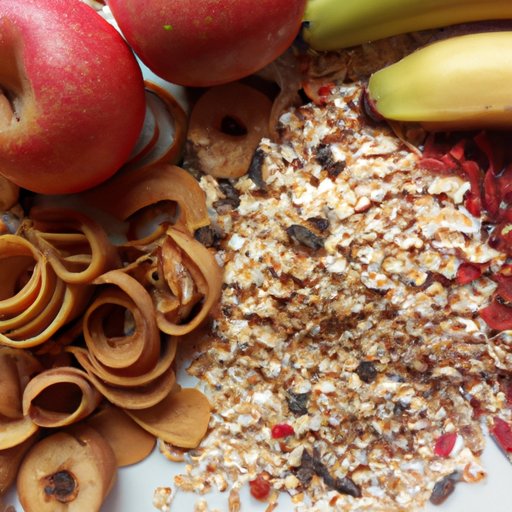
Introduction
You may have heard that a high-fiber diet can help you lose weight, but how exactly does it work? According to multiple studies, fiber has powerful effects on our body’s hunger and fullness signals, as well as our gut health. In this article, we will explore the science behind fiber and weight loss, as well as tips on how to incorporate high-fiber foods into your diet.
Highlighting the Benefits of High-Fiber Foods
Fiber is an essential nutrient that is often overlooked in our diets. It is found in plant-based foods, such as fruits, vegetables, whole grains, and legumes. There are two types of fiber: soluble fiber, which dissolves in water and forms a gel-like substance, and insoluble fiber, which does not dissolve in water and adds bulk to our waste.
So why is fiber important for weight loss? Firstly, fiber has a low calorie density, which means that it takes up more space in our stomachs without contributing to excess calories. Secondly, fiber slows down the digestion of food, which leads to a slower release of sugar into our bloodstream. This stabilizes our blood sugar levels and reduces the likelihood of cravings and overeating.
Research has shown that diets high in fiber are associated with a lower body weight and BMI, as well as a reduced risk of chronic diseases such as type 2 diabetes and heart disease. To incorporate more fiber into your diet, aim for at least 25-30 grams per day for adults.
Recipes for High-Fiber Meals and Snacks
Eating high-fiber meals and snacks doesn’t have to be boring or expensive. In fact, many high-fiber foods are low-cost and versatile. By incorporating more fruits, vegetables, whole grains, and legumes into your meals, you can create delicious and satisfying recipes that will keep you full for longer.
For breakfast, try a bowl of oatmeal topped with your favorite fruits and nuts, or make avocado toast with whole grain bread. For lunch or dinner, make a hearty lentil soup with plenty of vegetables, or grill some chicken or fish with a side of roasted vegetables. For snacks, choose apple slices with peanut butter, hummus with carrots and cucumber, or popcorn with herbs and spices.
When planning your meals, aim for a balanced plate that includes a variety of protein, healthy fats, and fiber-rich carbohydrates. This will not only help you stay full and satisfied, but also provide your body with all the nutrients it needs to function optimally.
The Link Between Gut Health and Weight Loss
The health of our gut is closely linked to our overall health and wellbeing. The gut is home to trillions of bacteria that play a crucial role in our digestion, immunity, and metabolism. Studies have shown that a healthy gut is associated with a healthy body weight, while an unhealthy gut can lead to inflammation, insulin resistance, and weight gain.
Fiber is essential for gut health, as it feeds the good bacteria in our gut and promotes a diverse microbiome. This leads to a stronger immune system, better digestion, and a lower risk of chronic diseases. To promote a healthy gut, aim for a diet that is rich in fiber, whole foods, and fermented foods, and avoid processed and high-fat foods that can disrupt the balance of bacteria in our gut.
Tips for Adding More Fiber to Your Diet
If you’re looking to add more fiber to your diet, there are many practical tips that you can follow. Firstly, make sure that you’re eating a variety of fruits and vegetables, especially those with high fiber content such as berries, leafy greens, and cruciferous vegetables. Secondly, choose whole grain foods such as bread, pasta, and rice, instead of refined grains that have been stripped of their fiber. Thirdly, add legumes such as lentils, chickpeas, and beans to your meals, as they are not only high in fiber but also protein and other micronutrients. Finally, read food labels to find low-sugar, high-fiber options for packaged foods such as cereal and snack bars.
Some common pitfalls to avoid when increasing your fiber intake include consuming too much fiber too quickly, which can cause bloating and discomfort, and not drinking enough water to help digest the fiber. It’s important to gradually increase your fiber intake over time and drink plenty of water throughout the day.
Exploring the Science Behind Fiber and Weight Loss
The reason why fiber is so effective for weight loss is due to its effects on our digestion and satiety signals. When we eat fiber, it absorbs water and expands in our stomachs, which triggers the release of hormones that tell our brain that we’re full and satisfied. This reduces the amount of calories we consume during a meal, without sacrificing the volume of food that we eat.
Furthermore, fiber slows down the rate of digestion and helps to stabilize blood sugar levels, which reduces the likelihood of cravings and overeating. Fiber also promotes a healthy gut and reduces inflammation, which in turn improves insulin sensitivity and metabolism.
Conclusion
In summary, a high-fiber diet has numerous benefits for weight loss and overall health. By incorporating more fiber-rich foods into your meals and snacks, you can increase satiety, reduce calorie intake, and promote a healthy gut. However, it’s important to gradually increase your fiber intake over time and balance it with other nutrients such as protein and healthy fats. Start small by adding more fruits, vegetables, and whole grains to your meals, and experiment with new recipes and snacks that incorporate high-fiber ingredients. Your body will thank you.
If you enjoyed this article, please share it with your friends and family and encourage them to add more fiber to their diets.




